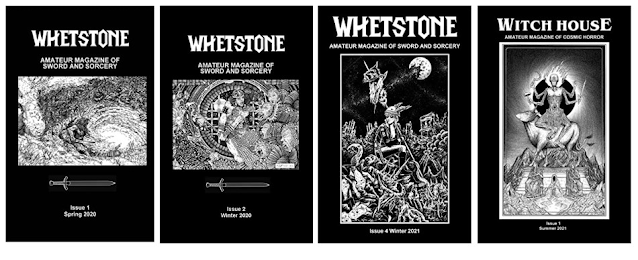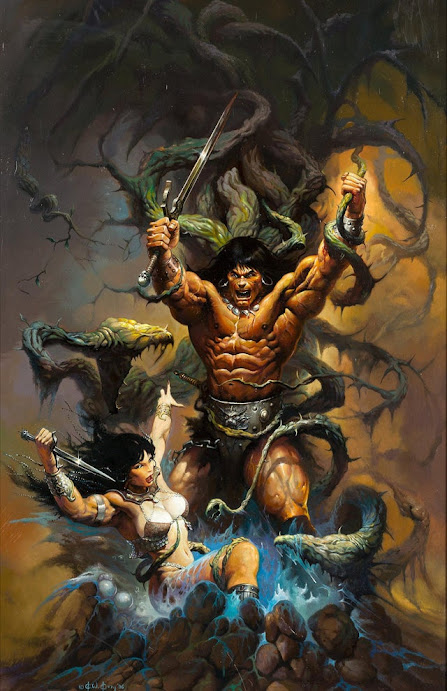Posted on Black Gate :
NEW TREASURES: FROLIC ON THE AMARANTHYN BY CHASE A. FOLMAR
Monday, March 28, 2022 SELindberg
Frolic on the Amaranthyn (Sable Star
Press,4/6/2022). Cover art by Goran Gligović
Frolic on the Amaranthyn will be published by
Sable Star Press on April 6th, 2022. It is 130 pages, priced at$7.99 paperback
and $2.99 in digital formats (available soon from Amazon, Barnes
& Noble, and others). Cover art by Goran Gligović. This
post announces the release and previews excerpts.
Chase A. Folmar has been demonstrating his command of Weird
Fiction, Sword & Sorcery (S&S), and the English language in various
short fiction entries (primarily via Whetstone: Amateur Magazine of
Sword & Sorcery & Witchhouse: Amateur Magazine of
Cosmic Horror online magazines). This novella, Frolic
on the Amaranthyn, seems to be his print debut. If you are not
familiar with his previous work, you may misconstrue the contents from the
title as being a fantasy romance (which it is not; and, you can check out his
stories in Whetstone #1 #2 #4 or Witchhouse #1).
If you are familiar with his works there, you will need to read Frolic
on the Amaranthyn. Chase A. Folmar (CAF) style is very reminiscent of Clark
Ashton Smith (CAS). Clark Ashton Smith was a contemporary of the Father of
S&S, Robert E. Howard, and Father of Cosmic Horror, Howard Phillips
Lovecraft (most of CAS’s fiction is online, as well as his nonfiction like his
essay on Atmosphere
in Weird Fiction). In short, do not expect fantasy romance; expect an
engaging, literary adventure.
Official Book Summary:
Channeling the artistic stylings of weird fantasists such as
Clark Ashton Smith and Jack Vance, Chase A. Folmar utilizes lush prose and
archaic vernacular to craft a wholly otherworldly setting for readers to
explore in this, his debut novella. We follow within the duo Uralant and
Emrasarie, brigands who employ their respective talents of swordsmanship and
seduction in the pursuit of precious coin. After the spoils of an orchestrated
heist are lost to them just as success seemed assured, the pair’s misfortune
only increases when, stranded in a strange city neither are familiar with, it
is revealed that their target had also been pursued by a sorcerer of the worst
and most dreaded kind, and that all his attention has now been directed towards
them. In order to escape the severity of his vengeance, they are forced to
comply with his fanatic whims and take part in a theft that will hopefully
strike clear the debt he has placed upon them. But that same theft will lead
them towards a dark secret behind the city’s beautiful façade, a secret tied to
a mysterious ark that travels down the waters of the Amaranthyn River on
certain nights, and upon which takes place what is known only as the Frolic.
Style & Excerpts
“My own conscious ideal has been to delude the reader into
accepting an impossibility, or series of impossibilities, by means of a sort of
verbal black magic, in the achievement of which I make use of prose-rhythm,
metaphor, simile, tone-color, counter-point, and other stylistic resources,
like a sort of incantation. You attain a black magic, perhaps unconsciously, in
your pursuit of corroborative detail and verisimilitude.” — 1930 letter to
Lovecraft, by Clark Ashton Smith
Within Frolic on the Amaranthyn dialogue is
sparse and the narrative is filled with obscure, abundant vocabulary. It is
surprisingly easy to read. As per the teaser quote above, CAF follows CAS’s
approach by stringing together words & feelings as if casting a strange
spell, a cadence, that will enthrall you. So, he’s sort of a thaumaturgist.
He’s on the radar now to corner about his thoughts on Beauty in Weird Fiction
(that’s a series of interviews we run here on Black Gate (link to
interviews).
Frankly, the title and blurb do not convey the intentional
weirdness you will experience. The literary prose-poetry will appeal to weird
fiction fans, and the vivid melee will appeal to Sword & Sorcery readers.
Check out these excerpts:
Poetic Prose
…and soon did Emrasarie find herself surrounded by a flock
of revelers similar to those she had earlier left. They had paraded up the same
hill as she, and now fell playfully to the grass about her, as if flower petals
cast aside by an infatuate pondering the affection carried their way by the one
whom they so ardently desired.
Emrasarie had not the strength, nor indeed the will, to
retreat this time. She simply watched as arms fumbled lazily through the air,
legs entwined with one another, and faces alight with the unearthly fire
overhead coalesced like streams of wax dripping from a weary candle. The other
face, so prevalent in her mind’s eye only a moment ago, had completely
disappeared. With it went the name it carried, and the affection she had felt
towards it. Nothing remained in the void of its absence. Nothing but beauty
seeking to smother her in its embrace. Beauty so much more preferable to all
that was ugly, coarse, and unforgiving in the world beyond…
Weird Melee
…Uralant spied several that had veered aside and were
instead making towards Emrasarie. Leaping with furious bounds, he hurled
himself across the distance separating them, and thrust like a battering ram
his sword at the nearest threat. Its length plunged clear through the enemy’s
torso, releasing a heavy spume of embers from its back as it crumpled from the
blow and collapsed.
Quickly pulling his weapon free, Uralant noted a thick,
glistening fluid of purest black now coated its tapered edges, bearing a
gaseous stench that lingered even as he leapt clear from a subsequent attack.
More talons cut through the air in a whirlwind of steel, and as Uralant dodged
about and kept the slashing monstrosity at bay, he realized no other sounds
came from any of these approaching demons. No roars or shrieks of fury, no
grunted breaths from exertion, no muttered curses or vows of vengeance for its
fallen companion; just the tearing of its hands through empty space, and red
eyes glaring at him, bright as the blood they were so desperate to spill.
Spying an opening, Uralant took the chance and swung high.
He felt the shattering of steel beneath steel, and the subsequent tear as a
rigid neck was severed through. When the head finally fell and crashed near his
feet, the eye set within it dimmed to a vacant black, and did not ignite again…
Expect More Folmar
Without spoiling, it is clear that Uralant and Emrasarie
will have more adventures to chronicle. The epilogue works in a mysterious,
angelic sorceress that begs for more attention as do the fates of some rare,
papyrus magic scrolls.
Chase A. Folmar Bio:
Chase A. Folmar is a writer of speculative fiction, especially
in the vein of weird fantasy and horror. He is one of the associate editors of Witch
House: Amateur Magazine of Cosmic Horror, and a member of the
Science Fiction and Fantasy Writers of Hampton Roads writing group. A graduate
of English Literature from the University of North Carolina at Asheville, Chase
has pursued his writing ambitions ever since, having been published in several
online magazines and amateur zines. Inspiration for his writing comes from all
across the literary spectrum, as well as the music he listens to and art he
invariably stumbles upon. He currently lives in Virginia with his wife and
their ever-growing horde of rescued pets.
www.chaseafolmar.com;
Twitter: @stranger_lands; CAF on Instagram


































